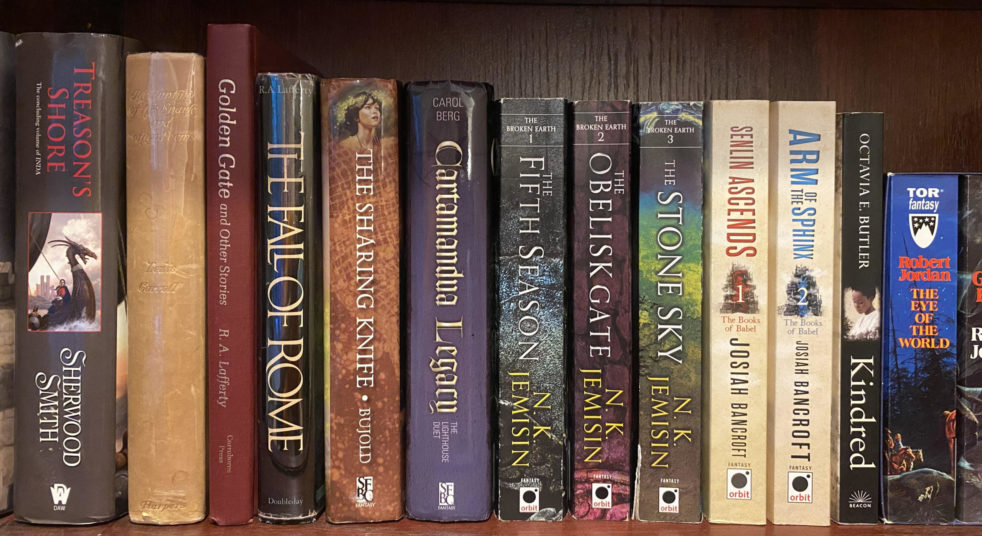
I haven’t done many of these, so I’ll start with a word about my series reviews. They are not reviews of the last book. They are meant to be helpful for people who have not read the series at all, or perhaps who have started and are unsure about whether to continue. As such, I will try to faithfully review the series considered as a whole without spoiling any individual book.
When I reviewed A Shadow in Summer–the first book of Daniel Abraham’s Long Price Quartet–back in December, I said that I expected the series to become a favorite. I knew that the common consensus was that the last three books were much better than the first, and the first had been my favorite book of the past year. But, deep down, I wasn’t sure that Abraham would be able to top his opener. He did and more, and my all-time top five has become a top six.
The Long Price Quartet takes place in a world with two dominant powers–an Eastern power (with clear East and Southeast Asian influences) consisting of several allied cities of the Khaiem, without much technology but with extremely powerful (albeit also extremely limited) magic, and an imperialistic Western power of Galt (with clear Germanic influences), without magic but with rapidly advancing industrial technology. The story is set almost entirely in the cities of the Khaiem, a rich land built out of the rubble of a once great Empire, stretching from tropical ports in the South to frozen mountain fortresses in the North. The Khai pit their older sons against each other in a struggle to become the lone survivor that will inherit the rule of their cities, and they send their younger sons to train as poets, learning to magically bind abstract concepts to do their will. While the cities rely on those bound concepts–the andat–for their economic and military power, the everyday citizens live lives mostly apart from either magic or technology, spending their time at work or in teahouses or in public baths, and communicating in a complicated language of speech and nonverbal gestures.
The series focuses both on internal struggles of the Khaiate cities–whether struggles for rule or for mastery over the andat–and the looming external threat of Galtic hostility, with the central conceit being the “long price.” Everything that happens in this series has consequences, and the beginning of each book is set 15 years following the end of the previous book, so the reader sees how choices–even the small-scale, personal decisions–made in one book reshapes the wider world to set up the conflict of the next. While there is some direct, armed conflict later on in the series (if you glance at the book titles, I’m sure you can guess when), The Long Price Quartet generally eschews fighting in favor of political plotting, with the main characters often finding themselves embroiled in schemes that they did not set in motion and desperately searching for the best of bad options.
May the gods keep us from a world where only the people who deserve love get it. -A Betrayal in Winter
Abraham’s writing really brings to life the day-to-day workings of the world while also meticulously plotting conflicts that stretch over a period of decades. But if there’s one aspect of the series that stands above the rest, it’s presenting utterly compelling and morally complex characters on both sides of conflict. Every protagonist in The Long Price Quartet makes mistakes, and every major antagonist is developed well enough for the reader to understand the reasons behind their actions–some of them are so convincing that the reader finds themselves actively sympathizing with the antagonist’s cause. If you’re looking for stories where every character feels real, where “the right thing to do” is rarely clear, or where the antagonist could’ve been the hero of another story, there are few better series than The Long Price Quartet.
Honestly, there aren’t many faults to find with the series. The general consensus seems to be that book one is a step below the other three, and while I agree that the opener–with its significant role as a scene-setter–is the slowest-paced of the bunch, I still found A Shadow in Summer to be one of my favorite books of 2020. I might downgrade it slightly in comparison to the absolutely incredible closing one-two punch of An Autumn War and The Price of Spring, but I find that the quality shines through from the very early going. Additionally, while the actions from each book reverberate through the rest of the series, each book does resolve its own central conflict, so picking up book one is not a commitment to reading all four.
If I have any complaint about the series, it’s that the religion in the Khaiate cities seems a bit half-baked. This is a people who swear by the gods, who have priests for certain public ceremonies, and who have incontrovertible evidence of the supernatural through the binding of the andat, but their religion plays no functional role in their lives and feels a bit like it’s tacked-on because pre-industrial societies are expected to be religious. But this is a complaint about the window-dressing, not about anything central to the series.
Overall, The Long Price Quartet is a fresh, creative fantasy series with fantastic characters and a perfect blend of personal and epic stakes. Anyone not actively averse to a slow pace or to scheming instead of fighting should give it a serious look.
Recommended if you like: three-dimensional characters, relatable antagonists, creative worldbuilding, personal and epic stakes.
Overall rating: 19 of Tar Vol’s 20. Five stars on Goodreads.
